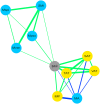Prognostic role of body composition parameters in gastric/gastroesophageal junction cancer patients from the EXPAND trial
- PMID: 31464089
- PMCID: PMC7015239
- DOI: 10.1002/jcsm.12484
Prognostic role of body composition parameters in gastric/gastroesophageal junction cancer patients from the EXPAND trial
Abstract
Background: Body fat and/or muscle composition influences prognosis in several cancer types. For advanced gastric and gastroesophageal junction cancer, we investigated which body composition parameters carry prognostic information beyond well-established clinical parameters using robust model selection strategy such that parameters identified can be expected to generalize and to be reproducible beyond our particular data set. Then we modelled how differences in these parameters translate into survival outcomes.
Methods: Fat and muscle parameters were measured on baseline computed tomography scans in 761 patients with advanced gastric or gastroesophageal junction cancer from the phase III EXPAND trial, undergoing first-line chemotherapy. Cox regression analysis for overall survival (OS) and progression-free survival (PFS) included body composition parameters and clinical prognostic factors. All continuous variables were entered linearly into the model as there was no evidence of non-linear prognostic impact. For transferability, the final model included only parameters that were picked by Bayesian information criterion model selection followed by bootstrap analysis to identify the most robust model.
Results: Muscle and fat parameters formed correlation clusters without relevant between-cluster correlation. Mean muscle attenuation (MA) clusters with the fat parameters. In multivariate analysis, MA was prognostic for OS (P < 0.0001) but not for PFS, while skeletal muscle index was prognostic for PFS (P = 0.02) but not for OS. Worse performance status Eastern Cooperative Oncology Group (ECOG 1/0), younger age (on a linear scale), and the number of metastatic sites were strong negative clinical prognostic factors for both OS and PFS. MA remained in the model for OS (P = 0.0001) following Bayesian information criterion model selection in contrast to skeletal muscle index that remained prognostic for PFS (P = 0.009). Applying stricter criteria for transferability, MA represented the only prognostic body composition parameter for OS, selected in >80% of bootstrap replicates. Finally, Cox model-derived survival curves indicated that large differences in MA translate into only moderate differences in expected OS in this cohort.
Conclusions: Among body composition parameters, only MA has robust prognostic impact for OS. Data suggest that treatment approaches targeting muscle quality are unlikely to prolong OS noticeably on their own in advanced gastric cancer patients, indicating that multimodal approaches should be pursued in the future.
Keywords: Computed tomography; Gastric cancer; Gastroesophageal junction cancer; Mean muscle attenuation; Prognosis; Sarcopenia; Smooth muscle index.
© 2019 The Authors. Journal of Cachexia, Sarcopenia and Muscle published by John Wiley & Sons Ltd on behalf of Society on Sarcopenia, Cachexia and Wasting Disorders.
Conflict of interest statement
None declared.
Figures


Similar articles
-
Modified Glasgow prognostic score (mGPS) is correlated with sarcopenia and dominates the prognostic role of baseline body composition parameters in advanced gastric and esophagogastric junction cancer patients undergoing first-line treatment from the phase III EXPAND trial.Ann Oncol. 2022 Jul;33(7):685-692. doi: 10.1016/j.annonc.2022.03.274. Epub 2022 Apr 5. Ann Oncol. 2022. PMID: 35395383 Clinical Trial.
-
Creatinine-to-cystatin C ratio and body composition predict response to PD-1 inhibitors-based combination treatment in metastatic gastric cancer.Front Immunol. 2024 Apr 11;15:1364728. doi: 10.3389/fimmu.2024.1364728. eCollection 2024. Front Immunol. 2024. PMID: 38665913 Free PMC article.
-
Skeletal Muscle Attenuation (Sarcopenia) Predicts Reduced Overall Survival in Patients with Advanced Epithelial Ovarian Cancer Undergoing Primary Debulking Surgery.Ann Surg Oncol. 2018 Oct;25(11):3372-3379. doi: 10.1245/s10434-018-6683-3. Epub 2018 Aug 1. Ann Surg Oncol. 2018. PMID: 30069659
-
Muscle mass, assessed at diagnosis by L3-CT scan as a prognostic marker of clinical outcomes in patients with gastric cancer: A systematic review and meta-analysis.Clin Nutr. 2020 Jul;39(7):2045-2054. doi: 10.1016/j.clnu.2019.10.021. Epub 2019 Nov 1. Clin Nutr. 2020. PMID: 31718876
-
Supratentorial hemispheric ependymomas: an analysis of 109 adults for survival and prognostic factors.J Neurosurg. 2016 Aug;125(2):410-8. doi: 10.3171/2015.7.JNS151187. Epub 2016 Jan 8. J Neurosurg. 2016. PMID: 26745489 Review.
Cited by
-
ASO Author Reflections: Impact of 1-Year Changes in Skeletal Muscle Quality on Prognosis in Postoperative Patients with Early Gastric Cancer.Ann Surg Oncol. 2024 Dec;31(13):9057-9058. doi: 10.1245/s10434-024-16127-6. Epub 2024 Aug 31. Ann Surg Oncol. 2024. PMID: 39215770 No abstract available.
-
Computed Tomography-Defined Fat Composition as a Prognostic Marker in Gastric Adenocarcinoma: A Systematic Review and Meta-Analysis.Dig Dis. 2023;41(2):177-186. doi: 10.1159/000527532. Epub 2022 Oct 13. Dig Dis. 2023. PMID: 36228589 Free PMC article.
-
CT-determined low skeletal muscle mass predicts worse overall survival of gastric cancer in patients with cachexia.Cancer Med. 2023 Jan;12(2):1492-1500. doi: 10.1002/cam4.5040. Epub 2022 Jul 18. Cancer Med. 2023. PMID: 35848533 Free PMC article.
-
Clinical significance of C-Reactive Protein to Lymphocyte Count Ratio as a prognostic factor for Survival in Non-small Cell Lung Cancer Patients undergoing Curative Surgical Resection.J Cancer. 2021 May 27;12(15):4497-4504. doi: 10.7150/jca.58094. eCollection 2021. J Cancer. 2021. PMID: 34149913 Free PMC article.
-
Quality of Life, Sarcopenia and Nutritional Status in Patients with Esophagogastric Tumors before and after Neoadjuvant Therapy.Cancers (Basel). 2024 Mar 21;16(6):1232. doi: 10.3390/cancers16061232. Cancers (Basel). 2024. PMID: 38539564 Free PMC article.
References
-
- Shen W, Punyanitya M, Wang Z, Gallagher D, St.‐Onge MP, Albu J, et al. Total body skeletal muscle and adipose tissue volumes: estimation from a single abdominal cross‐sectional image. J Appl Physiol (1985) 2004;97:2333–2338. - PubMed
-
- Bozzetti F. Forcing the vicious circle: sarcopenia increases toxicity, decreases response to chemotherapy and worsens with chemotherapy. Ann Oncol 2017;28:2107–2118. - PubMed
-
- Fujiwara N, Nakagawa H, Kudo Y, Tateishi R, Taguri M, Watadani T, et al. Sarcopenia, intramuscular fat deposition, and visceral adiposity independently predict the outcomes of hepatocellular carcinoma. J Hepatol 2015;63:131–140. - PubMed
-
- Harada K, Baba Y, Ishimoto T, Kosumi K, Tokunaga R, Izumi D, et al. Low visceral fat content is associated with poor prognosis in a database of 507 upper gastrointestinal cancers. Ann Surg Oncol 2015;22:3946–3953. - PubMed
MeSH terms
LinkOut - more resources
Full Text Sources
Medical

